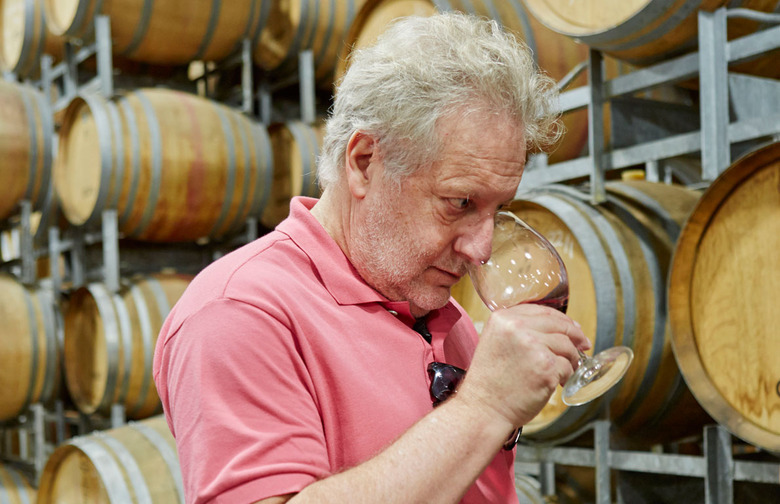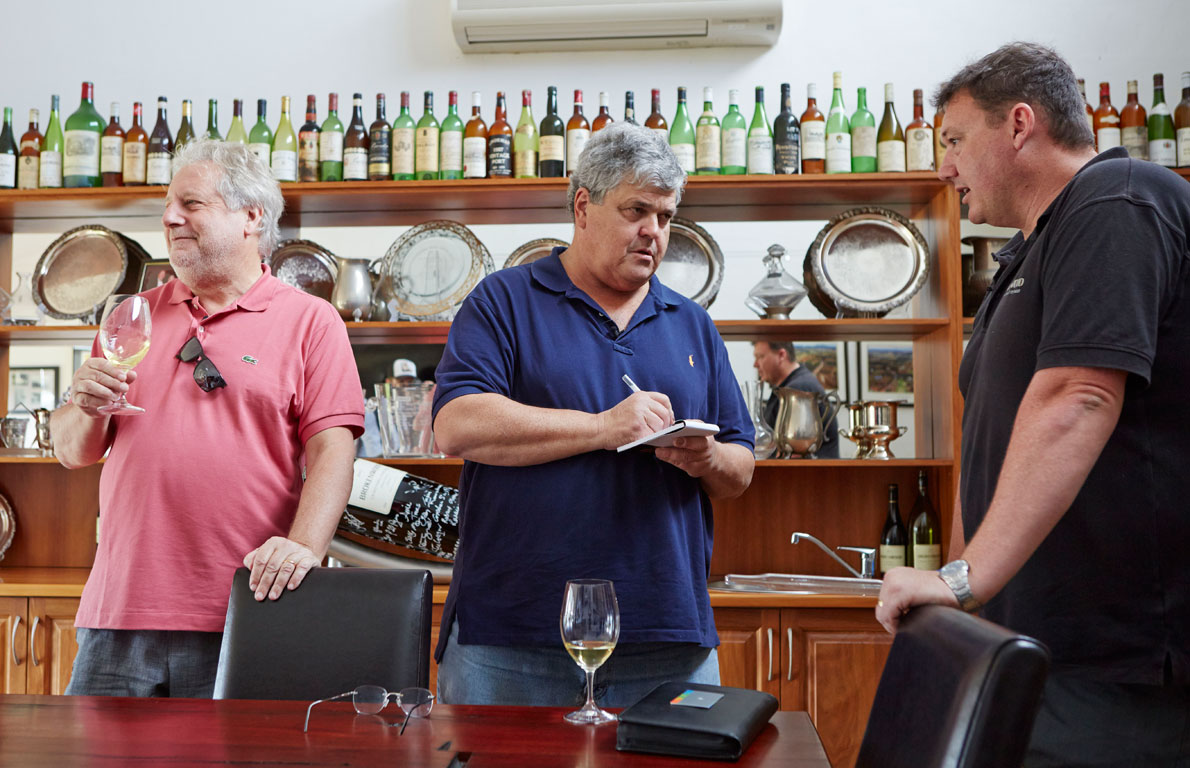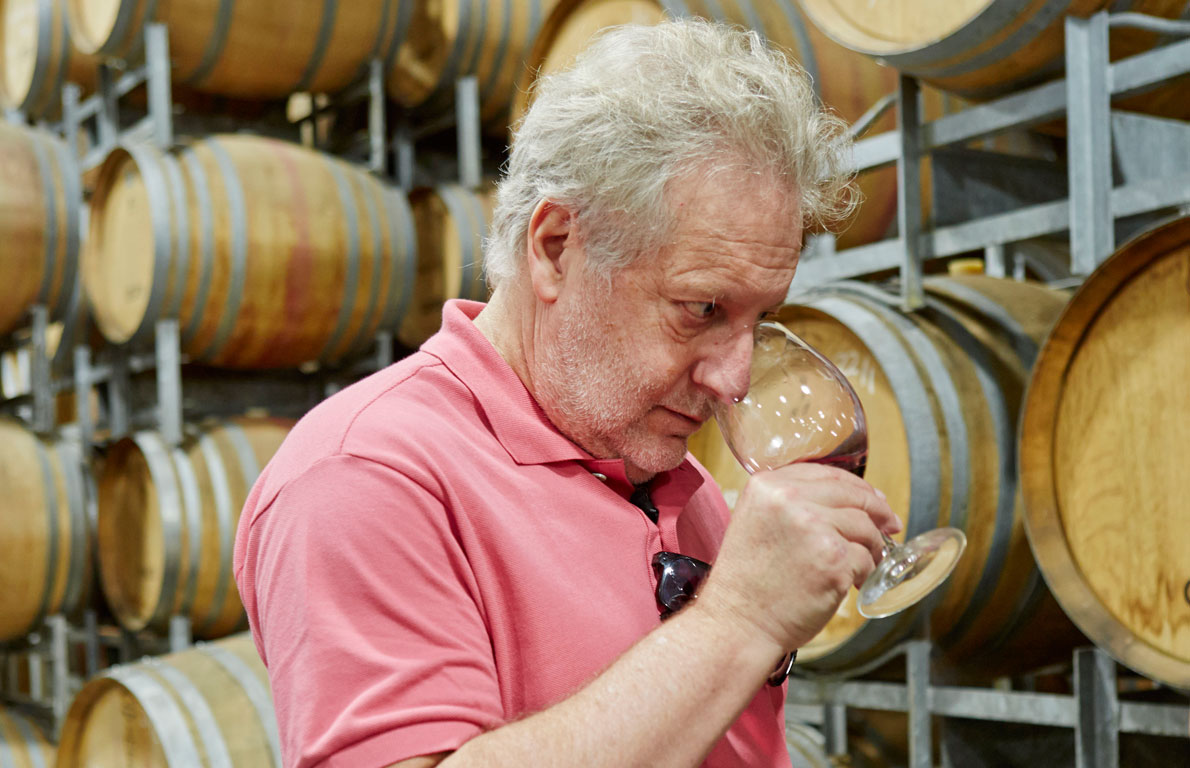The Hunter Valley: Stunning Semillon, Generous Shiraz, Delicious Food
If you look west while driving down the A-15 in Australia's Hunter Valley from Tamworth towards the turnoff for Broke Road, you might think for a moment that you're in the Napa Valley. Carpets of grapevines spread over rolling hillocks, with property lines defined by stands of oak trees and eucalyptus; a range of blue-green mountains marks the horizon. In the other direction, the landscape is more like Sonoma, flatter, with meadows and furrowed farmland interrupting the vines here and there. Then, in the late afternoon light, off the road in the woods, you see the kangaroos.
Though not as well-known internationally as South Australia's Barossa Valley and perhaps not as trendy among connoisseurs as Margaret River in Western Australia, the Hunter Valley is not only one of the country's major wine regions, but also the very birthplace of Australian wine. It is also the home of what is quite possibly the country's most significant and original contribution to the vinicological world: long-lived wines of great character and complexity made from France's sémillon grape, which in its native country is mostly blended with sauvignon blanc and sometimes muscadelle, and which rarely makes exceptional wine by itself anywhere but here.
With my old friend Jonathan Waxman — the wine-loving chef–restaurateur whose establishments include Barbuto in New York City, Adele's in Nashville, and Montecito in Toronto — I toured Hunter Valley late last year. We found a vibrant wine scene, plenty of good food, comfortable and sometimes luxurious accommodations (we loved Spicers Vineyards Estate, a sprawling five-star "guesthouse" outside the town of Pokolbin, surrounded by vineyards and native bushland), a first-rate producer of smoked meats and seafood (Lovedale Smokehouse), and, at the Hope Estate winery, an outdoor concert venue (the largest in Australia for the over-40 audience, we were told) at which, to our dismay, we had missed the Rolling Stones by one night — all less than a two-hour drive from Sydney.
The valley was a natural to become Australia's first wine country. Its proximity to Sydney (and thus to a ready clientele for its wares and a major port for export), its climate (humid, but less so than nearby coastal regions, and warmer than the higher elevations to the west), and its soils (including large tracts of sandy alluvial earth and crumbly loam) made it attractive to investors, who saw wine as a potential cash crop. The Australian government was all for the idea, too.
"Remember," Gus Maher, general manager of the Hunter Valley Wine and Tourish Association, told us when we sat down with him on our first morning in the region in the parlor at the Mercure Resort Hunter Valley Gardens hotel, "that Australia was a penal colony, and people came here drinking rum. The government wanted to get people off rum, and wine seemed like a good way to do it." The pioneer in this regard, he told us, was a Scotsman named James Busby, who traveled through the winelands of Europe and South Africa gathering cuttings (including syrah vines from Hermitage in France's northern Rhône, which was to be renamed shiraz here) and began planting them in 1825 on acreage he'd bought between the towns of Singleton and Branxton.
Others followed Busby's lead, and a selection of Hunter Valley wines sent to the Paris Exhibition of 1855 impressed judges so much that they chose a locally made sparkling wine to serve, instead of Champagne, to Emperor Napoléon III at the Exhibition's closing banquet. Despite this early acclaim, according to Maher, "Quality wines didn't really start appearing here until the 1950s or early '60s." Len Evans, whom Maher describes as "the first modern-day entrepreneur of the Australian wine industry" — he was the country's first regular wine columnist and founding director of the Australian Wine Bureau — was a great supporter of the region. One major local producer, Tyrrell's Wines, founded here in 1858, released the first commercial chardonnay made in Australia, called Vat 47, in 1971, thereby kick-starting an entire huge segment of the country's wine industry. Today, there are more than 120 wineries in the Hunter Valley.
Chardonnay is the most widely planted white wine variety planted in the area today, with sémillon coming second, but we're here mostly for the sémillon — and for the region's unusually elegant shiraz. We pretty much start at the top, visiting a winery called Brokenwood, founded in the 1970s by a group of hobby winemakers and now producing sémillon and shiraz of extraordinary quality (among other wines). The winery's top-of-the-line sémillon is the ILR Reserve (the initials are those of Brokenwood's managing director, chief winemaker, and co-owner, Iain Leslie Riggs), a wine released only after five years of bottle age.
The winery's wine education manager, Damien Harrison, met us in the Brokenwood tasting room and poured us two vintages of the ILR, the 2007, citrusy and spicy in aroma, with a nose of honey and beeswax, then rich, lemony, and almost oaky (though the wine sees no oak) on the palate. Waxman and I looked at each other in amazement; it was easily one of the best white wines we'd had all year. Both these wines are long sold out, but 2014 was a landmark vintage in the region, so make a note to watch for that one in 2019.
We got a preview of the vintage when Harrison took us into the barrel room, where we sampled the 2014 Graveyard Shiraz, beautifully rounded and full of intense cherry fruit, and much more Rhône-like than Australian in finesse and structure. "Twenty years ago, we were a little embarrassed by our shiraz in the Hunter," Harrison said, "because it wasn't a big 16-percent wine like they make in Barossa, but now we're very happy with what we can do."
The Braemore sémillons made by Andrew Thomas — named 2014 Hunter Valley Winemaker of the Year — at his Thomas Wines, a few miles from Brokenwood, are very different in style. We tasted his fresh, bright, lemony 2014 vintage, and then the same wine from 2008, and this was a clear illustration of how these wines can age: The older bottling was still bright in flavor, but had developed a toasty nose and an almost creamy texture with a current of minerality not found in the Brokenwood — delightful, if not quite the show-stopper we'd had at our previous stop. Thomas's star shiraz is called Kiss; judging from the 2014, tasted out of wood, it's sort of a sneaky wine, medium-bodied and refined at first sip, but hiding an impressive concentration of fruit that takes a few tries to get to. We agreed that we would love to taste this wine three or four years down the road.[pullquote:left]
Walking the vineyards and tasting vintages with amiable, ebullient Bruce Tyrrell, the fourth-generation Tyrrell to head up Tyrrell's Wines, is an energizing experience. His enthusiasm for his wines and for the Hunter Valley flows so easily and genuinely from him that it's contagious. It was probably Tyrrell who first recognized the aging potential of modern-day sémillon. The winery produced its first example in 1962, but it wasn't until the 1989 vintage that he decided to set 1,000 cases aside to bottle-age. His family was aghast at the idea, he later said, so he hid the wine for five or six years — and it was so good when they started sampling it that they institutionalized the practice. The winery's Vat 1 sémillon now gets seven years in the bottle before release. The 2004 vintage is elegant and still fresh, with a refined version of the toast-and-honey character these wines can develop.
Tyrrell's 2010 Vat 47 Chardonnay, about two-thirds of the grapes for which comes from the oldest chardonnay vines in Australia, is a classic, with very pronounced chardonnay flavor, nicely defined by a ring of acidity and given heft by just enough oak. The 2011 Vat 9 Shiraz is irresistible — bright and aromatic and beautifully structured, with lots of dense fruit touched with oak and a long, savory finish. Like the chardonnay, this comes largely from old vines. "Hunter and Barossa," Tyrrell told us, "never had phylloxera [the vine pest that devastated European vineyards in the nineteenth century], and today are probably the oldest repository of ungrafted European grape varieties in the world." (In these parts, a pest of more concern is the kangaroo, which enjoys snacking on the vine shoots and buds as they appear in the spring.)
We noted that, in speaking of this wine, Tyrrell pronounced the grape name as "she-rah" — as if he were combining the Australian and French names for it (shiraz and syrah, respectively). I told him that I'd always pronounced it "she-rawz," but that when I'd first visited the Margaret River area, far to the west, I heard everybody talking about "she-raaaz." Tyrrell laughed. "I tell our friends in Margaret River," he said, "that shiraz is warmth and generosity and 'she-raaaz' is an ugly word." He adds that, "In this region, unlike elsewhere in Australia, shiraz is about fruit and acidity, not tannin and alcohol."
Many of the Hunter Valley's best restaurants are attached or adjacent to wineries. In 2009, next to the Hungerford Hill wine estate, Troy and Megan Rhoades-Brown opened Muse Restaurant and Café, a sleek contemporary place with a soaring cantilevered roof and wrap-around floor-to-ceiling windows. Here, chef Troy uses products both local (Andrew Thomas verjuice, Binnorie goat cheese, Olio Mio olive oil, Hunter Valley partridge) and regional (Mandagery Creek venison from Orange, west of the Hunter Valley, Tasmanian ocean trout, Coppersfolly wasabi from New Zealand) to produce clean, authoritative dishes in a pleasingly international style. We were particularly taken with his roasted Milly Hill lamb from the northern Hunter Valley, with sweetcorn cream and garlic scapes, and his dessert of a reconstructed coconut half, its shell made of chocolate, its interior filled with coconut cream and coconut "air."
Before opening his own place, Rhoades-Brown was the executive chef at Roberts Circa 1876, across a field from Peppertree Wines, where the man in charge of the kitchen is now George Francisco, who came here from Jeremiah Tower's lamented Stars in San Francisco, by way of Sydney. Not unexpectedly, the menu at this old woodframe house turned restaurant has something of a California–Mediterranean feel to it, with dishes like ricotta-filled tempura zucchini flowers; spanner crab pasta with garlic, chile flakes, and Parmigiano; and roasted cod fillet with baby radishes, pea purée, and pea shoots. Some of Francisco's produce comes from a small garden next to the restaurant.
There's a much larger and more vigorous garden partially supplying Margan Restaurant, which is actually part of a winery, Margan Hunter Valley Wines. Proprietors Andrew and Lisa Margan, who designed their clean-lined, contemporary stone complex themselves, serve winery visitors what they call their "hundred-meter meal" — roast lamb with vegetables and a glass of barbera, with meat, produce, and wine grapes all raised or grown within about 300 feet of the table. Chef Michael Robertson served us a partially less local but more complex and very satisfying menu that included pastrami salmon with cucumber sorbet and kohlrabi purée; whipped goat curd with assorted tomatoes from the garden; roasted lamb loin and braised lamb shoulder with smoked potato purée, beets, and charred leeks; and a baked mango with mango mousseline and kaffir lime sorbet.
Taking a breather from sémillon and shiraz, we drank Margan's 2013 verdelho (this utilitarian Portuguese variety is the third most widely planted white wine grape in the region), full of tropical fruit aromas and flavors with a faint sweetness in the finish, and his 2011 barbera (vivid and spicy, with cherry fruit and suggestions of roast meat in the aroma) and 2011 (very dark in color and spicy, juicy, tannic, and intense).
Sitting on the terrace looking out on the Margan vineyards, sated with good food and glowing slightly from good wine, Waxman and I agreed that we liked the Hunter Valley pretty well — and that we'd definitely be back
Tasting at Brokenwood
Sampling 2014 Graveyard Shiraz


